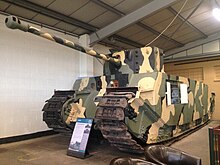| Heavy Tank, TOG II | |
|---|---|
 TOG II* at The Tank Museum, Bovington | |
| Type | Super-heavy tank |
| Place of origin | United Kingdom |
| Production history | |
| Designed | 1940[1] |
| Manufacturer | William Foster & Co.[1] |
| Produced | 1941[1] |
| No. built | 1 prototype |
| Specifications (TOG 2*) | |
| Mass | 80 long tons (81.3 metric tons)[2] |
| Length | 10.13 m (33 ft 3 in)[2] |
| Width | 3.12 m (10 ft 3 in)[2] |
| Height | 3.05 m (10 ft 0 in)[2] |
| Crew | 6 (Commander, gunner, 2 loaders, driver, co-driver) |
| Armour | 114 mm at the front of the turret and hull 76 mm at the sides of the hull, 50 mm at the rear of the tank[3] cemented armour on 12.7 mm (0.5 inch) mild steel |
Main armament | Ordnance QF 17-pounder |
Secondary armament | 7.92 mm Besa machine gun |
| Engine | Paxman-Ricardo 12-cylinder diesel-electric 600 hp (450 kW) |
| Power/weight | 7.5 hp/t |
| Transmission | 2 electric motors |
| Suspension | unsprung torsion bar (TOG II*) |
Operational range | 50 mi (80 km)[2] |
| Maximum speed | 8.5 mph (13.7 km/h) (achieved)[2] 15 mph (24 km/h) (theoretical)[4][page needed] |
The TOG 2, officially known as the Heavy Tank, TOG II, was a British super-heavy tank design produced during the early stages of World War II for a scenario where the battlefields of northern France devolved into a morass of mud, trenches, and craters as had happened during World War I. When this did not happen, the tank was deemed unnecessary, and the project terminated. A development of the TOG I design, only a single prototype was built before its termination.[5]